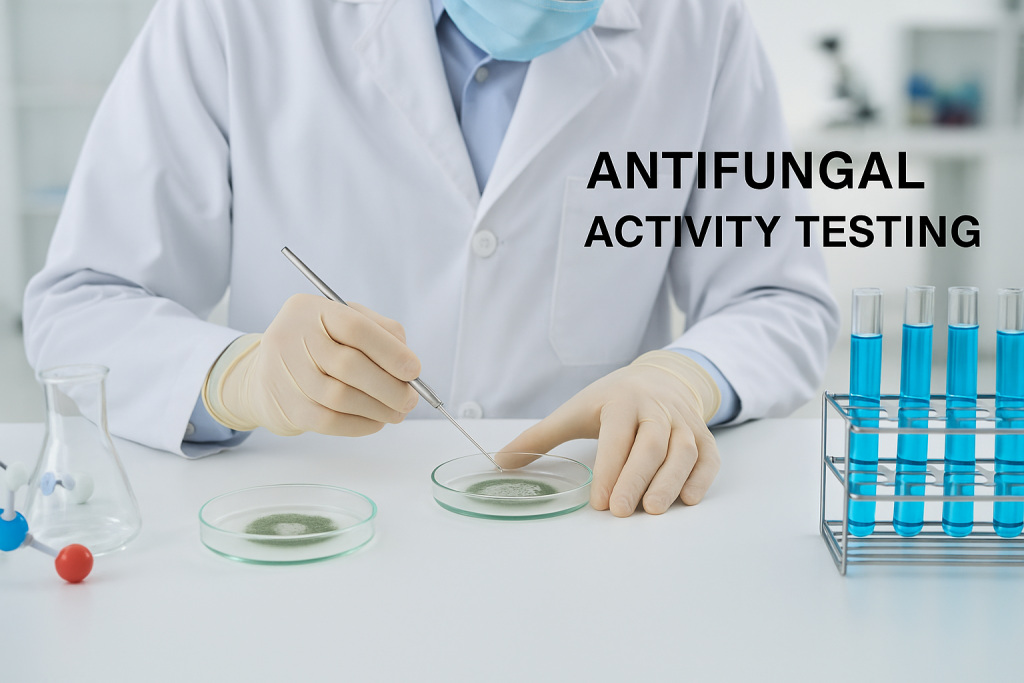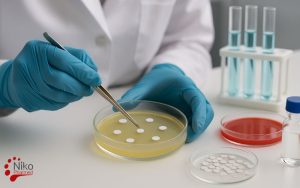What is Antifungal Activity Testing?
Antifungal activity testing is a set of standardized laboratory procedures designed to evaluate the efficacy of chemical agents, disinfectants, or bioactive substances against pathogenic or environmental fungi. These assays are critical both for product validation (e.g., disinfectants, hand sanitizers, medical devices) and are often performed alongside antibacterial testing to provide a full efficacy profile.. The testing determines whether a compound exhibits fungistatic (inhibiting fungal growth) or fungicidal (killing fungi) effects, under controlled and reproducible conditions.
Such testing may involve qualitative methods, such as agar well diffusion or disc diffusion assays to observe zones of inhibition, and quantitative approaches, including determination of the minimum inhibitory concentration (MIC), minimum fungicidal concentration (MFC), or growth curve analysis.
The choice of method depends on the type of fungi studied yeasts, dermatophytes, or filamentous fungi and the intended application. Ultimately, antifungal activity testing enables researchers to screen and characterize novel bioactive agents, compare their efficacy against standard antifungal drugs, and contribute to understanding their mechanism of action.
Antifungal Test Categories and Standards
Nikopharmed Laboratory implements such assays according to international reference standards (DIN EN, ASTM, ISO), ensuring results that are scientifically valid, reproducible, and acceptable for regulatory submissions. The laboratory evaluates antifungal properties of surface disinfectants, general-use chemical disinfectants, medical-use disinfectants, and hand disinfectants, each following specific protocols.
1. Antifungal Property of Surface Disinfectants (Non-Porous Surfaces)
Standards: DIN EN 13697
This standard evaluates the ability of disinfectants to reduce fungal contamination on non-porous surfaces (e.g., stainless steel, glass, ceramics). A known inoculum of fungal spores (commonly Candida albicans or Aspergillus brasiliensis) is applied to the test surface, dried under controlled conditions, and treated with the disinfectant. After exposure, any surviving fungi are recovered and quantified.
Outcome: Logarithmic reduction (e.g., 4-log = 99.99% reduction) is calculated, determining whether the disinfectant achieves the required antifungal efficacy.
2. Antifungal Property of General Chemical Disinfectants (Public Health Use)
Standards: DIN EN 1650
This suspension test assesses fungicidal activity of disinfectants intended for general public health applications (e.g., floor cleaners, surface sprays). A fungal suspension (standardized inoculum) is mixed with the disinfectant under defined conditions of concentration, contact time, and temperature. After neutralization of the disinfectant, surviving fungi are quantified using plate count methods.
Outcome: Demonstrates fungicidal effectiveness under practical conditions, providing evidence for claims of “fungicidal activity” on product labels.
3. Antifungal Property of Medical Disinfectants
Standards: DIN EN 13624
This test is specific to disinfectants used in medical and healthcare settings (e.g., surgical instruments, hospital surfaces). It measures antifungal efficacy against medically relevant fungi, simulating real clinical environments where infection control is critical. The method follows a suspension-based approach similar to EN 1650, but with stricter parameters and test organisms. Moreover, For medical devices, antifungal evaluations can be integrated into a broader biocompatibility and biological risk assessment strategy according to ISO 10993 and related standards.
Outcome: Ensures disinfectants used in hospitals and clinics are effective against fungal pathogens, thereby reducing the risk of healthcare-associated infections.
4. Antifungal Property of Hand Disinfectants
Standards: ASTM E2613, ISO 13624
These tests focus on hand hygiene products, such as alcohol-based hand sanitizers. Volunteers’ hands are artificially contaminated with a standardized fungal suspension, followed by application of the disinfectant under controlled conditions. Surviving fungi are then recovered from the skin and quantified.
Outcome: Provides data on the in vivo antifungal efficacy of hand disinfectants, directly relevant to infection prevention in both clinical and community settings.
Role of Nikopharmed Antifungal Testing Laboratory
Nikopharmed Laboratory conducts these antifungal activity testing services are backed by ISO/IEC 17025 certification and ILAC accreditation with precision instrumentation, trained microbiologists, and in compliance with GLP (Good Laboratory Practice).
To request testing or a complimentary consultation contact Nikopharmad
By applying DIN EN, ASTM, and ISO standards, the laboratory ensures that disinfectants are rigorously evaluated for fungicidal activity across diverse application areas from public health and medical settings to personal hygiene.
This systematic testing enables manufacturers to validate their product claims, meet international regulatory requirements, and ensure public safety by providing disinfectants with proven antifungal efficacy.


